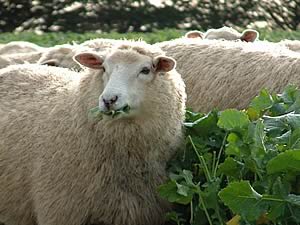| 2009-08-17
Summer sown stubble turnips have been shown in a joint ADAS and University of Bristol study to offer the essential combination of consistent eating quality and good cost control for winter lamb finishing.
New hybrid brassicas offer another out-wintered lamb finishing option that would be expected to deliver similar results to stubble turnips.
 |
Speaking at a recent EBLEX event at Walford and North Shropshire College, where the performance of 180 Texel cross Mule lambs had been investigated across three comparative systems, ADAS sheep specialist Kate Phillips stressed the significance of the work to British sheep farmers.
“There is currently a perception amongst retailers that British lamb finished outside the main grass grazing season lacks the consistency and eating quality of imported alternatives,” she explained. “Such perceptions drive supermarket buying policies and determine prices for British farmers.
“This work shows that the widely used system of finishing lambs over the winter period on brassicas, such as stubble turnips, can produce carcases of good quality and deliver the consistent eating quality that consumers want. It is also more cost effective than rearing lambs on supplemented grass silage or ad lib concentrates, so really does present a ‘win:win’ for sheep farmers.”
The study compared growth rates and production costs of three different finishing systems and then carried out texture, juiciness, flavour and preference analysis on these carcases.
As Kate Phillips explains, the results clearly showed the dual advantages of the brassica-based system.
“Stubble turnips provided a uniform diet and in taste tests this was shown to consistently deliver lamb with high ratings for texture, flavour and overall liking throughout the winter. In contrast, the assessors’ overall liking for lamb from grass silage and concentrate based systems tended to decline with later slaughtering (See Table: Influence of Feed and Slaughter Date on Lamb Eating Quality).
“Feed costs were estimated for each of the production systems and results showed that stubble turnips compared favourably with the grass finishing system both in terms of overall cost and cost/kg of liveweight gain. Ad lib concentrate feeding was the most expensive overall (see Table: Overall Feed Costs), though higher growth rates later on gave this system a lower cost/kg liveweight gain than the silage and concentrate system.”
As cereals and wholecrop harvesting is completed, August is an ideal time to establish stubble turnips for lamb finishing, according to Helen Mathieu of British Seed Houses, who also spoke at the Walford meeting.
“This is another good example of how brassica fodder crops offer alternative routes to profitability for livestock farmers,” she added. “Soils are warm and moist currently and stubble turnips can be scratched in to stubbles or direct drilled to provide a very cost effective system of finishing top quality lamb. Similar cost benefit and meat quality results could be expected from other brassica fodder crops, such as the new hybrid brassicas Swift or Redstart.”
 Highlighting the Benefits of EBVs Highlighting the Benefits of EBVs
 New Sheep Autotagger from Ritchey New Sheep Autotagger from Ritchey
 Quality Southdown Sheep Genetics in Demand Quality Southdown Sheep Genetics in Demand

|





